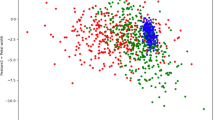Abstract
The study of the classification of Apples and Oranges in a warehouse has been undertaken in a three-qubit system using the method of repeated iterations in Grover’s algorithm and Ventura’s algorithm separately. Operator describing an inversion about average has been constructed as a square matrix of order eight, the phase inversion operators and corresponding iteration operators for patterns separately representing Apples and Oranges have been derived, and various possible superpositions as the choice for search states for the classification of these patterns have been obtained for starting states consisting of two patterns and a single pattern, respectively. It has been demonstrated that on the second iteration of the exclusion superposition by the corresponding iteration operators, the patterns Apples and Oranges, respectively, are most suitably classified using the Grover’s algorithm. The probabilities of classifications of Apples have also been calculated by using Ventura’s algorithm (Ventura and Martinez in Inf Sci 124:273–296, 2000; Found Phys Lett 12:547–559, 1999) for all the possible superpositions as the search states, and the results have been compared with those of Grover’s algorithm and it has been demonstrated that in general for classification of a given pattern (Apples) in three-qubit system, the Grover’s and Ventura’s algorithms are effective in the cases where the number of patterns in the stored database is larger or smaller, respectively.



Similar content being viewed by others
References
Feynman, R.P.: Simulating physics with computers. Int. Theor. Phys. 26(21), 467–488 (1982)
Shor, P.W.: Algorithms for quantum computation: discrete logarithm and factoring. In: Proceedings of 35th Annual Symposium, Found of Computer Science, Los. Alamitos, IEEE Comp. Press, pp. 20–22 (1994)
Grover, L.K.: A fast quantum mechanical algorithm for data base search. In: Proceedings of 28th Annual ACM Symposium On Theory of Computing, Philadelphia, Pennsylvania, ACM Press, pp. 212–221 (1996)
Simon, D.: On the power of quantum computation. SIAM J. Comput. 26(5), 1474–1483 (1997)
Ezhov, A.A., Nifanova, A.V., Ventura, Dan: Quantum associative memories with distributed queries. Inf. Sci. 128, 271–293 (2000)
Li, S.S., Nie, Y.Y., Hong, Z.H., Yi, X.J., Huang, Y.B.: Controlled teleportation using four-particle cluster state. Commun. Theor. Phys. 50, 633–640 (2008)
Huang, Y.B., Li, S.S., Nie, Y.Y.: Controlled dense coding between multi particles. Int. J. Theor. Phys. 48, 95–100 (2009)
Li, S.S.: Dense coding with cluster state via local measurement. Int. J. Theor. Phys. 51, 724–730 (2012)
Wang, Z.S., Wu, C., Feng, X.L., Kwek, L.C., Lai, C.H., Oh, C.H., Vedral, V.: Non-adiabatic geometric quantum computation. Phys. Rev. A 76, 044303–307 (2007)
Wang, Z.S.: Geometric quantum computation and dynamical variable operators. Phys. Rev. A 79, 024304–308 (2009)
Jennewein, T., Simon, C., Weihs, G., Weinfurter, H., Zeilinger, A.: Quantum cryptography with entangled photons. Phys. Rev. Lett. 84, 4729–4732 (2000)
Naik, D.S., Peterson, C.G., White, A.G., Burglund, A.J., Kwiat, P.G.: Entangled state quantum cryptography. Phys. Rev. Lett. 84, 4733–4736 (2000)
Tittel, W., Bendel, J., Zbinden, H., Gisin, N.: Quantum cryptography using entangled photons in energy-time bell states. Phys. Rev. Lett. 84, 4737–4740 (2000)
Tan, H.T., Zhang, W.M., Li, G.: Entangling two distant nanocavities via a waveguide. Phys. Rev. A 83, 032102–108 (2011)
Singh, Manu P., Rajput, B.S.: Role of entanglement in quantum neural networks (QNN). J. Mod. Phys. 6, 1908–1920 (2015)
Singh, Manu P., Rajput, B.S.: Maximally entangled states of two-qubit systems. Int. J. Theor. Phys. 52, 4237–4255 (2013)
Singh, Manu P., Rajput, B.S.: Applications of Singh-Rajput MES in recall operations of quantum associative memory for a two-qubit system. Int. J. Theor. Phys. 54(10), 3443–34460 (2015)
Singh, Manu P., Rajput, B.S.: Processes of quantum associative memory (QuAM) through new maximally entangled states (Singh-Rajput MES). Int. J. Theor. Phys. 55(2), 124–140 (2016)
Singh, Manu P., Rajput, B.S.: Pattern classification in two-qubit and three-qubit systems. Euro. Phys. J. Plus 129(57), 1–13 (2014)
Singh, Manu P., Rajput, B.S.: New maximally entangled states and pattern classification. Int. J. Theor. Phys. 53(9), 3226–3238 (2014)
Grover, L.K.: Quantum mechanics helps in searching for a needle in haystack. Phys. Rev. Lett. 79, 325–328 (1997)
Wootters, W.K.: Entanglement of formation and concurrence. Quantum Inf. Comput. 1(1), 27–44 (2001)
Ventura, D., Martinez, T.: Quantum associative Memory. Inf. Sci. 124, 273–296 (2000)
Ventura, D., Martinez, T.: Initializing the amplitude distribution of a quantum state. Found. Phys. Lett. 12, 547–559 (1999)
Arima, K., Miyajima, H., Shigei, N., Maeda, M.: Some properties of quantum data search algorithms. IN: The 23rd International Conference on Circuits/Systems, Computers and Communications (ITC-CSCC 2008)
Ventura, D.: On the utility of entanglement in quantum neural computing. In: Proceedings of International Joint Conference on Neural Networks, pp. 1565–1570 (2001)
Acknowledgements
Authors thankfully acknowledge the financial support of University Grants Commission (UGC), New Delhi (India), in the form of a major research project: MRP-Major-Comp-2013-39460. They also express their gratefulness to Prof. B.S. Rajput for useful discussion and encouragement.
Author information
Authors and Affiliations
Corresponding author
Rights and permissions
About this article
Cite this article
Singh, M.P., Radhey, K., Saraswat, V.K. et al. Classification of patterns representing Apples and Oranges in three-qubit system. Quantum Inf Process 16, 16 (2017). https://doi.org/10.1007/s11128-016-1472-z
Received:
Accepted:
Published:
DOI: https://doi.org/10.1007/s11128-016-1472-z




